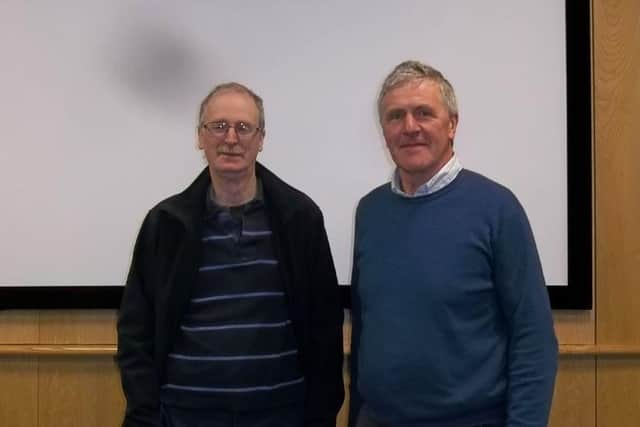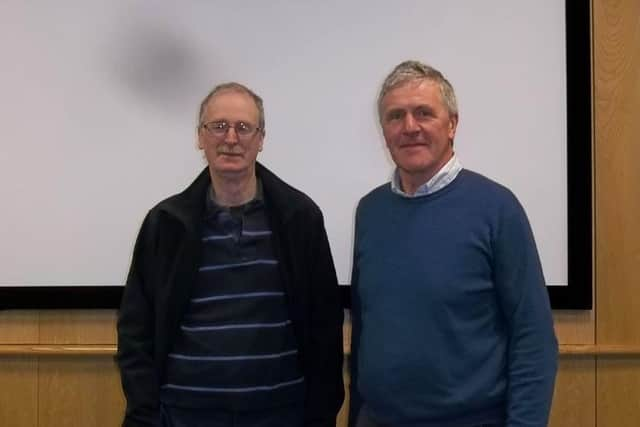Minimum tillage crops experience in Co Down
and live on Freeview channel 276
The guest speaker was Downpatrick area based cereal grower, Mr Iain McMordie, who described his experience in controlling his mechanisation costs by his choice and use of farm machinery for combinable crops husbandry.
His description of the evolution of the machinery types and sizes from those used on his home farm reminded us of the steady evolution of crop technology and methods.
Advertisement
Advertisement
Iain grew up on the family farm and went on to graduate with an Agricultural Science degree from Reading University in 1979. He subsequently joined the then DANI (Department of Agriculture for Northern Ireland ) advisory services as a farm mechanisation adviser.


By 2006, when part of its Co Armagh farm advisory team, he opted for a career break which facilitated his return to direct practical involvement with his family farm where the main enterprises were in cereal production.
Soon afterwards he commenced a business arrangement with his farming friend and neighbour, John Gill, to share the use of machinery across their enterprises.
They also commenced a diversification venture, with Norfolk based E H Haylage, to grow and process 200 acres of forage for haylage to supply local equestrian markets.
Advertisement
Advertisement
After several years they decided to increase their joint cereal growing enterprises. This led to an opportunity to enter a share-farming enterprise with David Chambers, another arable farmer in the area. The increased combined scale of this venture encouraged their investigation and implementation of the most cost-efficient yield - friendly husbandry systems.


As a result their resulting policy is now based on:
n Reduced cultivations – saving energy and time compared to the conventional ploughing and seed bed preparation techniques traditionally used in the area.
n Improvement in field efficiency and working conditions by the appropriate choice and shared use of good quality, high capacity second-hand equipment.
n The use of appropriate precision farming technology to guide accurate field work, reduce waste and record field yield performances.
Evolution of field machinery systems for combinable crops
Advertisement
Advertisement
Typically during the 1970s, the McMordie farm’s arable land was ploughed with a four-furrow plough on a 65hp 2wd tractor, tilth was prepared with a rotatiller before broadcast distribution of the seed and fertilizer from a Vicon wagtail spreader.
Iain grew up on the family farm and went on to graduate with an Agricultural Science degree from Reading University in 1979.
The field surface was leveled using a flat harrow and firmed with a Cambridge roller. Weed control was by tractor mounted boom sprayer. When the crop was ripe it was harvested with a trailed 6’ Dania combine powered by a 65 hp tractor and the bulk grain was then dried on an angle-tray batch drier before storage.
Changes, from the 1980s, in the mechanisation systems included getting a seed drill seed with a tramline kit to facilitate the use of a 12m sprayer (a step up from a 20’ Allman sprayer).
Advertisement
Advertisement
Reversible ploughing with an 78hp 4wd tractor was followed by a power harrow / drill combination for a one pass sowing operation. A self propelled combine now did the harvesting before the grain was dried with a p.t.o.-driven, gas-fired portable recirculating batch machine all purchased second hand.
Tractor types
Associated additions to the tractor fleet included a 4wd MB Trac tractor with equal size wheels and duals for seedbed work . This tractor could travel at up to 40kph on the road and had advanced features for its time including a comfortable wide cab, suspended front axle , hydraulic brakes on both axles and a high capacity system for trailer braking.
Its load platform design also facilitated its carrying the tank and 16 m booms from a used trailed type Hardi crop sprayer adapted to “demount” type.
A second hand 4wd Deutz 4.50A loader tractor was added to assist with the field work which now included selective use of a multi-tined shakerator to treat any local areas of compaction and a 6m Cambridge roller for seedbed consolidation.
Advertisement
Advertisement
As area increased bigger tractors , used for draft cultivation and other work now include a 2008 2170 JCB Fastrac and a 2002 Fendt 920 replacing the previous tractors.
Changes, from the 1980s, in the mechanisation systems included getting a seed drill seed with a tramline kit to facilitate the use of a 12m sprayer (a step up from a 20’ Allman sprayer).